The equity rally off the October lows has erased much of the 2022 declines but challenging terrain lies ahead as the Fed attempts to complete its mission.
A Closer Look at What’s Driving the Rally
Following a double-digit decline in both equities and fixed income in 2022, investors braced for continued headwinds and the potential for a recession in 2023. Yet, at the midpoint of 2023, equity markets have experienced a significant rally off of the October lows. With equities defying both expectations and weaker economic indicators, such as declining earnings expectations, investors are questioning if we are in a new bull market or a bear market rally.
The S&P 500 has rallied over 26% from its Q4 trough and is now within 5% of regaining its all-time high achieved in early 2022. However, a look under the hood reveals a lack of breadth in the equity recovery, which has been skewed by a handful of mega-cap growth stocks. Following significant corrections in 2022, Apple, Microsoft, NVidia, Amazon, Tesla, Meta and Alphabet drove over 70% of year-to-date performance for the index as investors sought out the combination of the new year rebound, perceived mega cap safety, and exposure to Artificial Intelligence (“AI”) innovation.
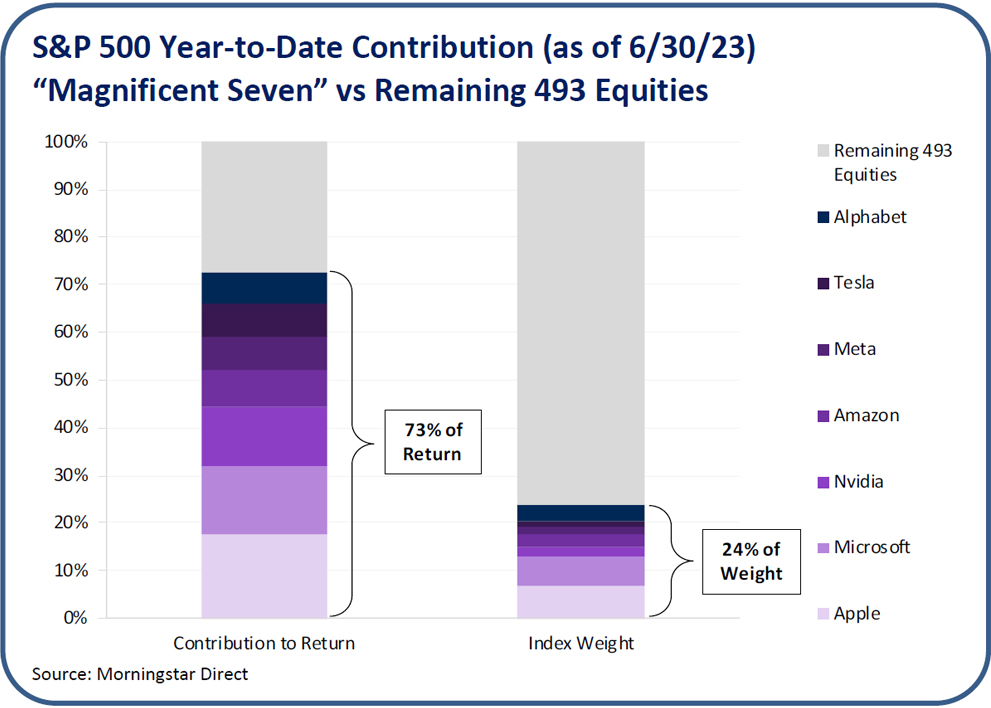
While year-to-date breadth has been narrow, upside participation broadened out in June. Growth equities continued to rally, but value stocks, cyclical sectors and small caps joined the rebound as well.
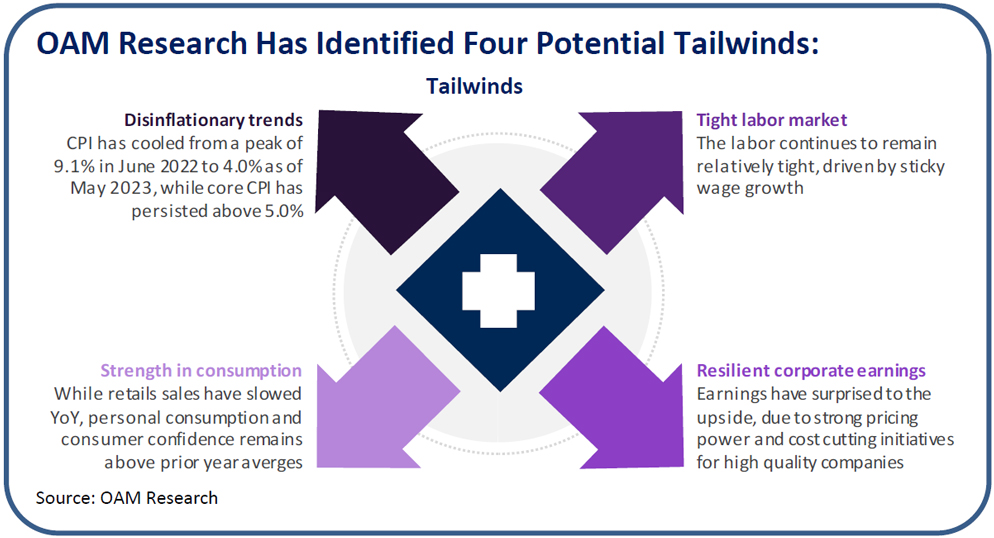
The recent equity strength masks a complex macro environment wherein early signs of a potential recession have emerged, but U.S. consumers, buoyed by a robust labor market and elevated wage growth, have supported economic growth in the near-term. On the positive side, a disinflationary trend has emerged in recent months as the Consumer Price Index (“CPI”) has come off record highs from June 2022 at 9.1% to 4.0% as of May 2023. At the same time, the U.S. labor market has remained surprisingly resilient and persistent wage growth has allowed consumers to continue to support the economy. Consumer spending has remained durable, especially in service-oriented sectors that represent approximately 80% of GDP and initially lagged in the preliminary phases of the economy reopening. If consumers remain employed and willing to spend, then companies with pricing power can pass along cost increases to customers to protect profit margins and deliver strong results for shareholders. While there has been some relief in cost pressures, the Street set a low bar coming into Q1 earnings by aggressively downgrading estimates, which likely contributed to better-than-expected earnings with 77% of companies reporting results above analyst expectations, well above the long-term average of 66%.
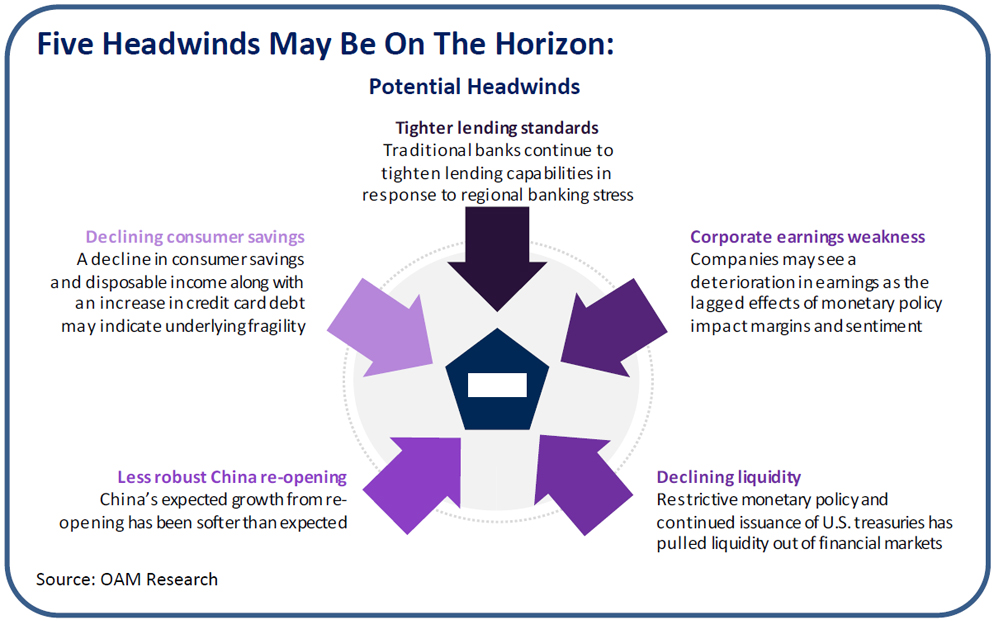
Although the U.S. economy has seemingly remained above water, there are a number of headwinds or warning signs that signal potential weakness on the horizon. While inflationary pressures seem to be easing, the pace of disinflation has been disappointing and certain areas of the economy have proven to be stickier than expected. Core CPI remains high at 5.3% and has shown few signs of cooling. In addition, due to the base effects of comparing to prices a year ago, there is a strong possibility that we see the annualized change in the CPI reverse course and start to rise again in the coming months. Indeed, although the Fed paused their rate hikes in June, they insist that inflation remains an issue with the potential for additional hikes expected later this year. Even if the Fed is nearing the end of their tightening cycle, given the long and variable lags of monetary policy we do not anticipate policy easing until we witness a material disinflationary trend or if the economy experiences a significant slowdown.
Continued elevated interest rates have the potential to disrupt the resiliency of the consumer-driven economy, and the effects of tight monetary policy are starting to show. Personal savings rates are declining, consumers are increasing their reliance on credit to fund purchases, and disposable income is waning, which may be further emphasized as Americans with outstanding student loans resume payments on the debt starting in October 2023. On the business side, if rates remain elevated or continue to rise, demand starts to falter and input prices remain elevated then profit margins will come under further pressure. While the labor market has largely remained intact, there are a few early indicators that signal a potential weakening. 4-week average jobless claims have been trending higher in 2023 with a meaningful move up in June. The lagged impacts of rate hikes seem to be making their way through the labor market slowly given higher jobless claims, but we could see further weakness if the unemployment rate ticks up in the future as it did in May and wage growth slows alongside goods disinflation.
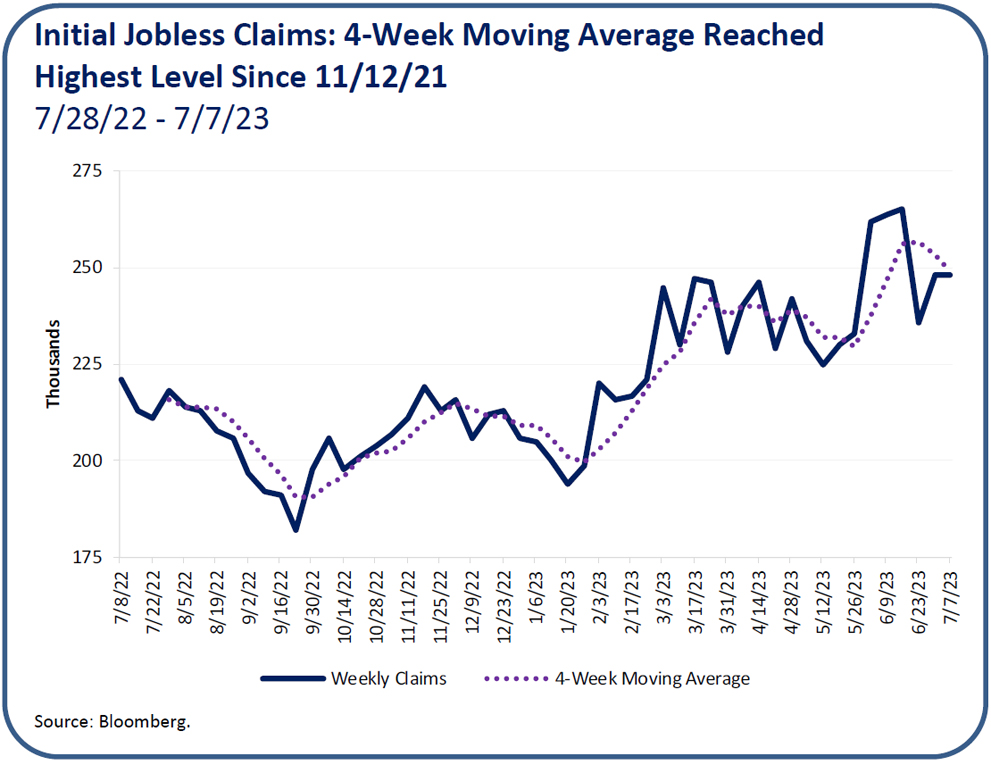
Potential Opportunities Exist in Underperforming Areas, Core Fixed Income, and Diversifying Strategies
Despite these potential headwinds, OAM Research believes there are opportunities in this market and investors should remain disciplined and selective in their equity investments. While AI may have a profound impact on our economy over the long-term, it is too early to declare definitive winners and these stocks may experience a challenge of sustaining lofty valuations, with the NASDAQ reaching a forward P/E of 36x. Instead of chasing recent winners, investors may be better served seeking out underperforming areas, such as value equities or small cap stocks that carry more reasonable valuations. Ultimately, higher quality companies with healthy balance sheets that are trading at fair valuations should be well-positioned over the intermediate term as underlying headwinds may overhaul market optimism.
To counter equity risk, core fixed income has become increasingly attractive over the past few quarters. Yields in the investment-grade space are near their highest levels since the financial crisis, and with the Fed potentially nearing the end of its hiking cycle, it can be an opportune time to start adding or building upon high quality fixed income exposure to portfolios. Ultimately, if Fed policy does induce a recession, high-quality fixed income, such as core bonds, should provide protection for portfolios if defaults and delinquencies rise.
In our view, investors should also continue to consider meaningful allocations to diversifying strategies such as event-driven/merger arbitrage to reduce equity and interest rate risk. Many diversifying strategies provided significant downside protection in 2022 when equities struggled and interest rates rose.
Macroeconomic and Asset Class Views
In this section, OAM Research offers sector-specific opinions derived from ongoing analysis of valuations, momentum, economics, business cycle and fund flows. It is important to note that some asset classifications changed since the last quarter. The changes are defined in the chart below.
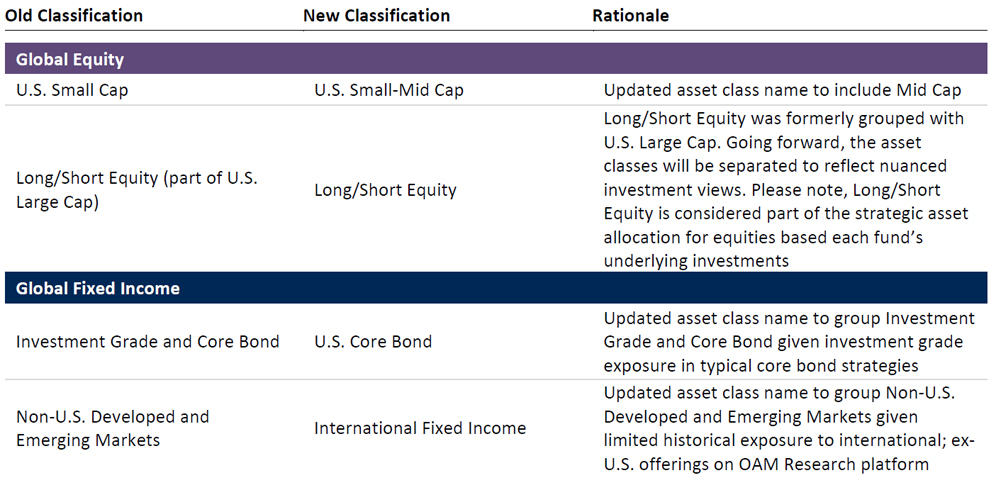
Global Equity
U.S. Large Cap Large caps offer investors an attractive blend of quality, yield and growth, but valuations have stretched further following a significant rally in mega-cap growth stocks this year. U.S large cap equities appear priced for perfection despite the challenging macro backdrop. Although the consumer and the labor market have been resilient, the full impact of the Fed’s aggressive tightening is likely still making its way through the economy. Higher-quality companies with pricing power should be more resilient, and investors may benefit from allocating to strategies focused on quality and downside protection.
Current View: Neutral
Most major economies outside of the U.S. are contending with weakening growth, elevated inflation, and hawkish central banks. International equities continue to trade at meaningful discounts, but given the economic uncertainties there appears to be more downside risk.
Current View: Slightly Negative
Although Europe avoided an energy crisis, most major economies are still facing a material economic slowdown and most central banks remain hawkish given the persistence of inflation. International equities continue to trade at meaningful discounts, but given the economic uncertainties there appears to be more downside risk.
Current View: Slightly Negative
Valuations remain reasonable compared to history and look attractive relative to U.S. equities. Still, economic growth in emerging economies is expected to slow meaningfully, and emerging-market stocks tend to be more volatile in the face of uncertainty. Slowing growth and Covid-related lockdowns in China pose a greater risk given the country’s weight in the index and its influence on many other regions.
Current View: Neutral
Long/Short Equity Long/short strategies should benefit from increased dispersion and market dislocation, leveraging active management of both long and short positions. However, if a broad downward revision of earnings across sectors were to occur, it would likely adversely impact strategies.
Current View: Slightly Positive
Global Fixed Income
Interest rates have remained volatile, but yields are much higher today than they were a year ago, providing a buffer from a total return standpoint. With the Fed nearing the end of their hiking cycle it can be an opportunity to add duration. Investment-grade credit spreads remain reasonable and corporate balance sheets are generally healthy. Spreads for high-quality securitized products represent attractive entry points.
Current View: Slightly Positive
Spreads have tightened year-to-date and look tight if the U.S. is heading for recession. The default rate remains below average but defaults rose in 2022 and so far in 2023 and could accelerate if the economy worsens. However, yields more than doubled in 2022 and high-yield bonds provide considerably more income today. Investors may prefer short-term high yield that carries a similar yield but with less duration risk.
Current View: Neutral
Yields overseas have similarly improved over the last year and a half. However, most developed market rates remain less attractive than U.S. yields, and investors may face more pain from further central bank tightening to fight higher inflation. Emerging market debt looks more attractive within the non-U.S. market, both from a yield perspective and as a portfolio diversifier.
Current View: Slightly Negative
Diversifying Strategies
Midstream energy infrastructure has continued to perform well despite falling commodity prices due to improved fundamentals and attractive yields. Other infrastructure segments with lower equity betas should provide stability in the face of more volatility. REITs continue to feel pressure from interest rates and loan concerns, but valuations have improved and fundamentals in many segments remain sound.
Current View: Slightly Positive
Multi-strategy, macro and CTA strategies have performed well amid elevated volatility, higher commodity prices and an increase in rates. If this environment continues, we expect these strategies to produce positive returns. However, they may offer limited upside if we see the risk-on and beta-driven environment continue in the near term.
Current View: Slightly Positive
Macro strategies have performed well in an environment that has seen significant volatility and higher commodity prices. If this environment continues, then we expect their strong performance to continue.
Current View: Neutral
Reach out to your Oppenheimer Financial Professional if you have any questions.
Disclosure
The opinions expressed herein are subject to change without notice. The information and statistical data contained herein has been obtained from sources we believe to be reliable. Past performance is not a guarantee of future results.
The above discussion is for illustrative purposes only and mention of any security should not be construed as a recommendation to buy or sell and may not represent all investment managers or mutual funds bought, sold, or recommended for client’s accounts. There is no guarantee that the above-mentioned investments will be held for a client’s account, nor should it be assumed that they were or will be profitable. OAM Consulting is a division of Oppenheimer Asset Management Inc. (OAM). OAM is an indirect, wholly owned subsidiary of Oppenheimer Holdings Inc., which also indirectly wholly owns Oppenheimer & Co. Inc. (Oppenheimer), a registered broker dealer and investment adviser. Securities are offered through Oppenheimer.
For information about the advisory programs available through OAM and Oppenheimer, please contact your Oppenheimer financial advisor for a copy of each firm’s ADV Part 2A.
Adopting a fee-based account program may not be suitable for all investors; anticipated annual commission costs should be compared to anticipated annual fees.
S&P 500 Index (“SPX”) is a well-known, broad-based stock market unmanaged index which contains only seasoned equity securities. The Fund does not restrict its selection of securities to those comprising the SPX. Performance of the SPX is provided for comparison purposes only. While the Fund’s portfolio may contain some or all of the stocks which comprise the SPX, the Fund does not invest solely in these stocks.
Russell 1000 Value Index measures the performance of the large cap value segment of the US equity universe. It includes those Russell 1000® companies with lower price-to-book ratios and lower expected growth values. The Index is constructed to provide a comprehensive and unbiased barometer for the large-cap value segment. The index is completely reconstituted annually to ensure new and growing equities are included and that the represented companies continue to reflect value characteristics.
Russell 1000 Growth Index measures the performance of the large cap growth segment of the US equity universe. It includes those Russell 1000® companies with higher price-to-book ratios and higher forecasted growth values. The Index is constructed to provide a comprehensive and unbiased barometer for the large-cap growth segment. The index is completely reconstituted annually to ensure new and growing equities are included and that the represented companies continue to reflect growth characteristics.
NASDAQ Composite Index tracks the performance of about 3,000 stocks traded on the Nasdaq exchange. The index is calculated based on market cap weighting.
VIX Index Created by the Chicago Board Options Exchange (CBOE), the Volatility Index, or VIX, is a real-time market index that represents the market's expectation of 30-day forward-looking volatility. Derived from the price inputs of the S&P 500 index options, it provides a measure of market risk and investors' sentiments.
MSCI AC World ex-USA Index captures large- and mid- cap representation across 22 of 23 developed-market countries (excluding the U.S.) and 24 emerging-market countries.
LTM PE Ratio is the last 12-month price-to-earnings ratio.
Indices are unmanaged, do not reflect the costs associated with buying and selling securities and are not available for direct investment.
Risk Factors
The success of an investment program may be affected by general economic and market conditions, such as interest rates, the availability of credit, inflation rates, economic uncertainty, changes in laws and national and international political circumstances. These factors may affect the level and volatility of securities prices and the liquidity of a portfolio’s investments. Unexpected volatility or illiquidity could result in losses. Investing in securities is speculative and entails risk. There can be no assurance that the investment objectives will be achieved or that an investment strategy will be successful.
Special Risks of Foreign Securities
Investments in foreign securities are affected by risk factors generally not thought to be present in the United States. The factors include, but are not limited to, the following: less public information about issuers of foreign securities and less governmental regulation and supervision over the issuance and trading of securities. International investments may involve risk of capital loss from unfavorable fluctuation in currency values, from differences in generally accepted accounting principles or from economic or political instability in other nations.
Special Risks of Small- and Mid-Capitalization Companies
Investments in companies with smaller market capitalization are generally riskier than investments in larger, well established companies. Smaller companies often are more recently formed than larger companies and may have limited product lines, distribution channels and financial and managerial resources. These companies may not be well known to the investing public, may not have significant institutional ownership and may have cyclical, static or moderate growth prospects. There is often less publicly available information about these companies than there is for larger, more established issuers, making it more difficult for the Investment Manager to analyze that value of the company. The equity securities of small- and mid-capitalization companies are often traded over-the-counter or on regional exchanges and may not be traded in the volume typical for securities that are traded on a national securities exchange. Consequently, the investment manager may be required to sell these securities over a longer period of time (and potentially at less favorable prices) than would be the case for securities of larger companies. In addition, the prices of the securities of small- and mid- capitalization companies may be more volatile than those of larger companies.
Special Risks of Fixed Income Securities
For fixed income securities, there is a risk that the price of these securities will go down as interest rates rise. Another risk of fixed income securities is credit risk, which is the risk that an issuer of a bond will not be able to make principal and interest payments on time. Liquidity risk is the risk that you might not be able to buy or sell investments quickly for a price that is close to the true underlying value of the asset. When a bond is said to be liquid, there's generally an active market of investors buying and selling that type of bond.
Fixed income securities markets are subject to many factors, including economic conditions, government regulations, market sentiment, and local and international political events. Further, the market value of fixed-income securities will fluctuate depending on changes in interest rates, currency values and the creditworthiness of the issuer.
High Yield Fixed Income Risk
High yield fixed income securities are considered to be speculative and involve a substantial risk of default. Adverse changes in economic conditions or developments regarding the issuer are more likely to cause price volatility for issuers of high yield debt than would be the case for issuers of higher grade debt securities. In addition, the market for high yield debt may be less attractive than that of higher-grade debt securities.
Special Risks of Master Limited Partnerships
Master limited partnerships are publicly listed securities that trade much like a stock, but they are taxed as partnerships. MLPs are typically concentrated investments in assets such as oil, timber, gold and real estate. The risks of MLPs include concentration risk, illiquidity, and exposure to potential volatility, tax reporting complexity, fiscal policy and market risk. MLPs are not suitable for all investors.
Forward Looking Statements
This presentation may contain forward looking statements or projections. These statements and projections relate to future events or future performance. Forward-looking statements and projections are based on the opinions and estimates of Oppenheimer as of the date of this presentation, and are subject to a variety of risks and uncertainties and other factors, such as economic, political, and public health, that could cause actual events or results to differ materially from those anticipated in the forward-looking statements and projections. 4870159.1

